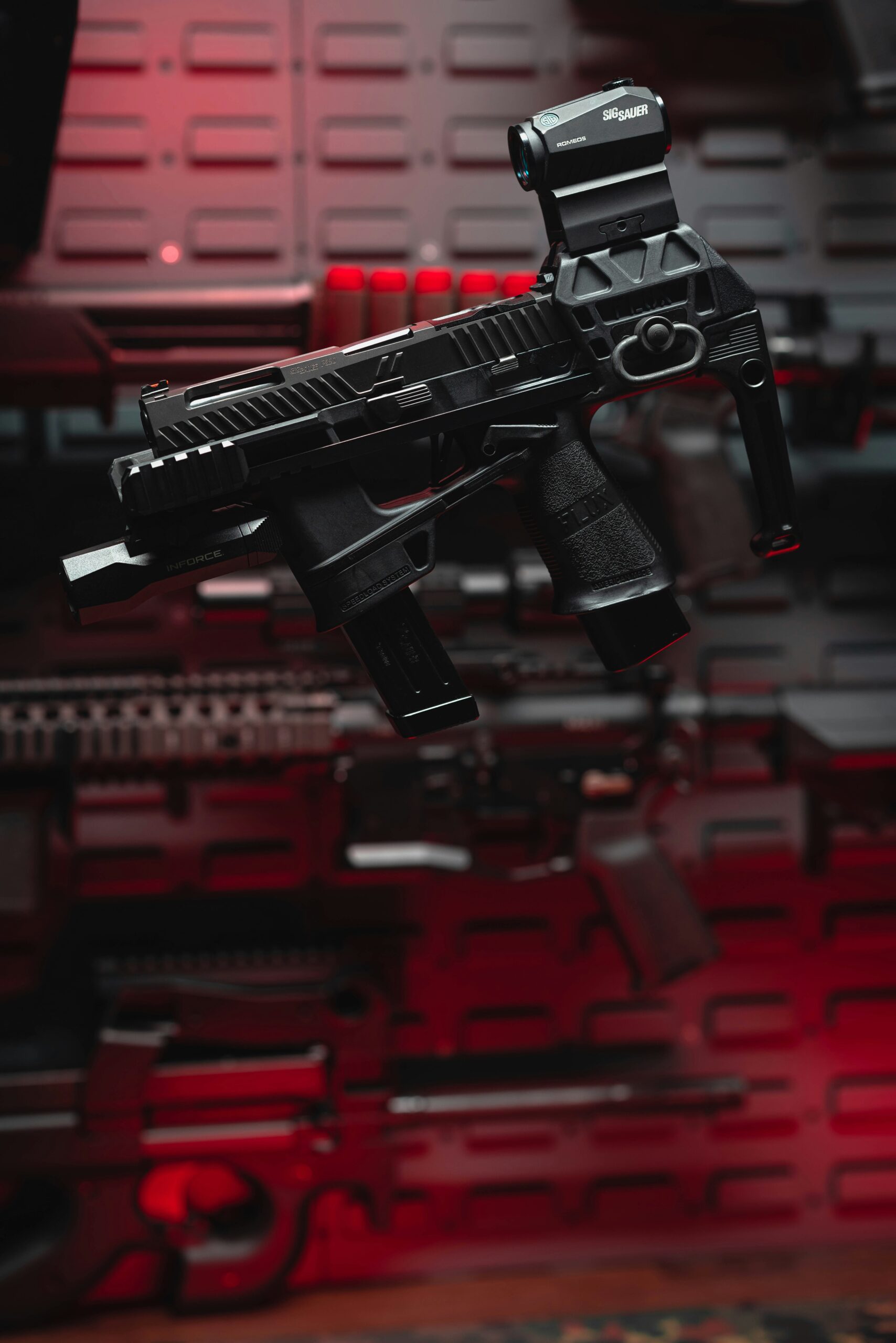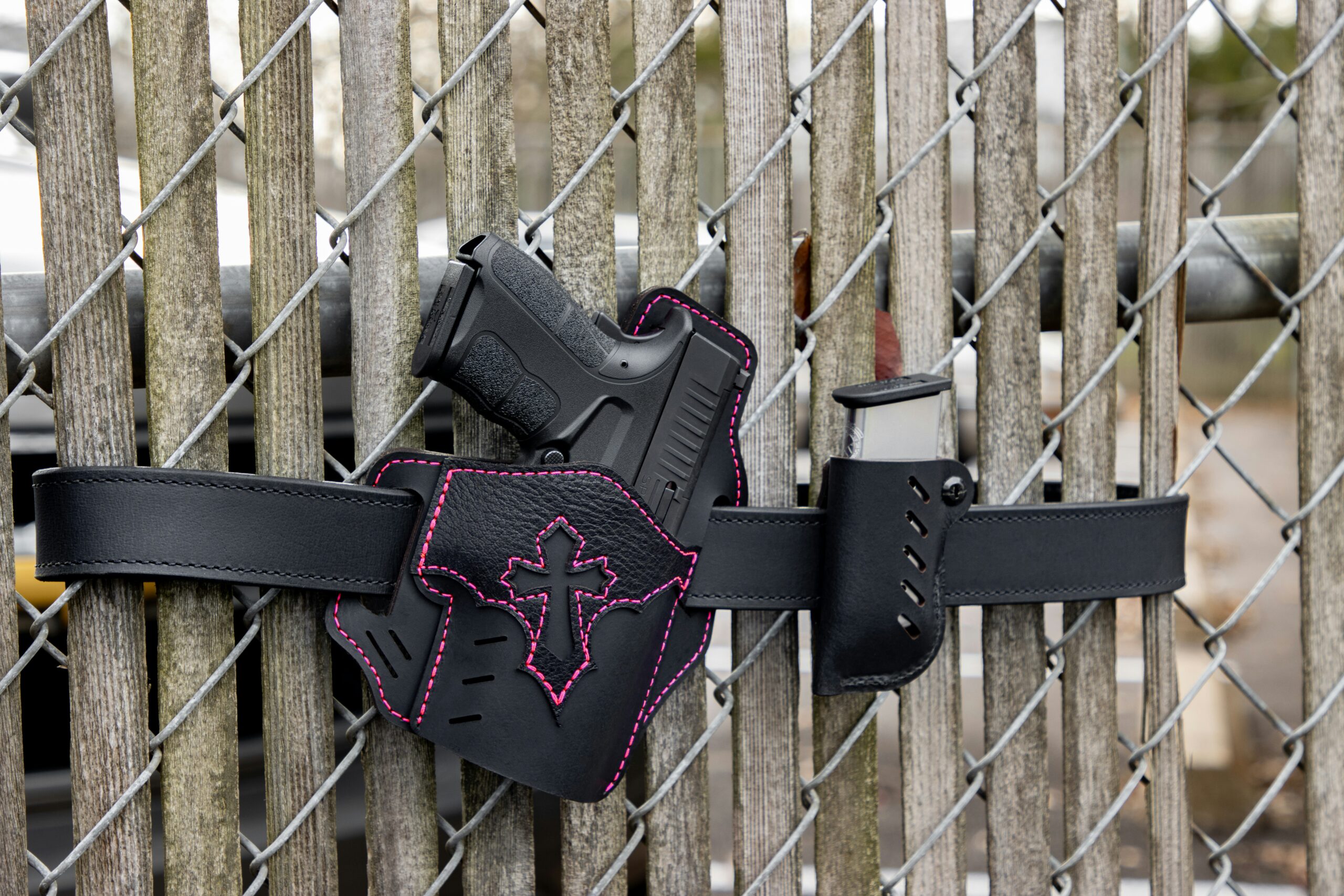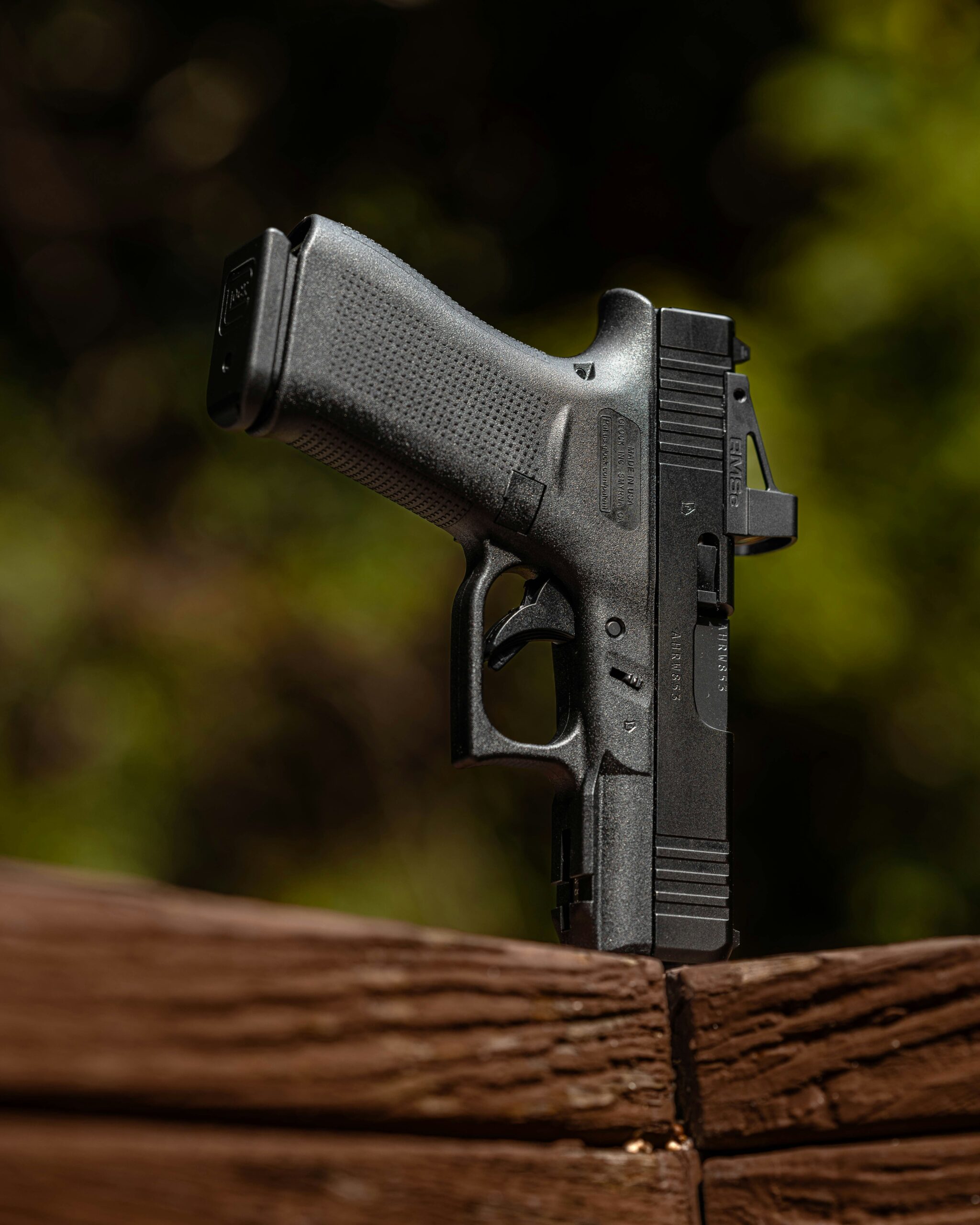Imagine being able to shoot targets from a much greater distance with your trusty handgun. Sounds like something out of a movie, right? Well, it turns out that with the right equipment, like a rifle scope, this could become a reality for any firearm enthusiast. In this article, we explore the potential of using a rifle scope on a handgun to increase its effective range. Buckle up and prepare to have your shooting game taken to new heights!

Concept of Effective Range
Definition of Effective Range
The effective range refers to the distance at which a firearm can reliably and accurately engage a target. It is influenced by various factors including the weapon’s design, ammunition type, shooting skill, and external conditions. Understanding the effective range of a firearm is crucial for determining its limitations and optimizing its use.
Factors Determining Effective Range
Several factors contribute to the determination of a firearm’s effective range. The design characteristics of the weapon, such as barrel length, caliber, and overall build quality, play a significant role. Additionally, the type and quality of ammunition used can affect the range and accuracy.
Shooter proficiency is another critical factor. Skill in aiming, trigger control, and managing recoil can greatly impact the effective range. External factors such as wind, temperature, and visibility also need to be considered as they can affect bullet trajectory and accuracy.
How to Maximize Effective Range
To maximize the effective range of a handgun, several steps can be taken. First and foremost, selecting a firearm with a longer barrel can increase velocity and thus extend the range. Additionally, using high-quality ammunition specifically designed for longer-range shooting can enhance accuracy and consistency.
Regular practice and training are essential for improving shooting skills and increasing effective range. Developing proper shooting techniques, including a stable stance, steady grip, and smooth trigger control, can greatly impact accuracy and extend the effective range.
Understanding the Use of Handguns
Features of Handguns
Handguns, also known as pistols, are lightweight firearms designed to be fired with one hand. They are typically used for personal defense, sport shooting, and law enforcement purposes. Handguns come in various designs, including semi-automatic and revolver configurations.
The main components of a handgun include the frame, barrel, slide (in semi-automatic pistols), cylinder (in revolvers), and the grip. Handguns are known for their compactness, ease of use, and versatility in close-quarters engagements.
Common Types of Handguns
There are several types of handguns commonly used today. Semi-automatic pistols, such as the Glock or Sig Sauer, are popular due to their magazine-fed design and quick reloading capability. Revolvers, like the Smith & Wesson Model 686, utilize a rotating cylinder to hold and fire multiple rounds.
Other specialized types of handguns include single-shot pistols, derringers (small concealable pistols), and compact concealed carry pistols. Each type has its own advantages and limitations, making it important to choose the right handgun for the intended purpose.
Basics of Handgun Shooting
Mastering the basics of handgun shooting is essential for accuracy and effectiveness. A proper shooting stance involves a solid foundation with feet shoulder-width apart, knees slightly bent, and body weight evenly distributed.
Grip technique is crucial for controlling recoil and maintaining a steady aim. The dominant hand wraps around the grip with firm, even pressure, while the non-dominant hand supports the firearm. Trigger control is another critical aspect, requiring a smooth, controlled squeeze to avoid disrupting the sight picture.
Role of Handguns in Sports and Personal Defense
Handguns serve various purposes, including sport shooting and personal defense. In sport shooting disciplines like IPSC (International Practical Shooting Confederation) or IDPA (International Defensive Pistol Association), handguns are used to engage targets with speed and precision, testing the shooter’s skills under different scenarios.
In terms of personal defense, handguns offer individuals a compact and portable firearm for protecting themselves and their loved ones. The ease of concealability makes them a popular choice for those seeking personal protection while maintaining a low profile. However, proper training and adherence to local laws and regulations are crucial to ensure safe and responsible use.
Traditional Handgun Sighting Systems
Open Sights on Handguns
Open sights are the most common sighting system found on handguns. They consist of a front sight, often a post or blade, and a rear sight, typically a notch or groove. The shooter aligns the front and rear sights to center the target, ensuring accurate aim.
Open sights are versatile and allow for quick target acquisition, making them suitable for close-quarters encounters. However, they can be challenging to use at longer distances due to potential sight picture misalignment and decreased precision.
Aperture Sights for Handguns
Aperture sights, commonly referred to as peep sights, feature a small circular opening in the rear sight. The shooter looks through the aperture, focusing on the front sight and aligning it with the target. Aperture sights provide a more precise sight picture compared to open sights.
While aperture sights are commonly used on rifles, they are less prevalent on handguns. Their smaller size and potential interference with slide movements make them less popular for handgun applications. However, some firearm models offer optional aperture sight systems for shooters who prefer this sighting method.
Reflex Sight Systems for Handguns
Reflex sight systems, also known as red dot sights, offer a different approach to handgun sighting. These electronic sights project an illuminated dot or reticle onto a transparent lens, allowing the shooter to align the dot with the target.
Reflex sights provide several advantages, including fast target acquisition, unlimited eye relief, and enhanced aiming precision, even in low-light conditions. However, they may require a slight adjustment in shooting technique compared to traditional iron sights.

Exploring the Use of Rifle Scopes
Fundamentals of Rifle Scopes
Rifle scopes are optical devices mounted on rifles to enhance accuracy and target visibility. They consist of a series of lenses and a reticle, allowing the shooter to aim with increased precision at various distances. Rifle scopes are widely used in hunting, competitive shooting, and military applications.
The primary components of a rifle scope include the ocular lens, erector system, objective lens, and the reticle (commonly known as crosshairs). Scopes can have adjustable magnification settings to offer the shooter flexibility in adapting to different shooting scenarios.
Telescopic Sights: How They Work
Telescopic sights, also known as scopes, work by focusing and magnifying the image of the target. When the shooter looks through the ocular lens, the light from the target passes through multiple lenses, which converge the image onto the shooter’s eye.
Most rifle scopes have adjustable magnification settings, allowing the shooter to zoom in or out on the target. This feature enables shooters to engage a variety of targets at different ranges, making rifle scopes highly versatile tools in the hands of a skilled shooter.
Different Types of Rifle Scopes
There are various types of rifle scopes available, each designed to meet specific shooting requirements. Some common types include fixed-power scopes, variable-power scopes, and specialized scopes for different shooting disciplines.
Fixed-power scopes have a single magnification setting, such as 4x or 6x, and are popular for close to medium-range shooting. Variable-power scopes, on the other hand, allow the shooter to adjust the magnification level within a specified range, providing flexibility for engaging targets at different distances.
Specialized scopes cater to specific shooting disciplines and may include features such as illuminated reticles, bullet drop compensators, or range-finding capabilities. These advanced scopes streamline the shooting process and enhance accuracy for shooters engaging targets at varying distances.
Adapting Rifle Scope to Handguns: Feasibility and Challenges
Physical Possibility of Adapting Rifle Scopes to Handguns
Adapting a rifle scope to a handgun is technically possible, as both firearm types have compatible mounting systems. Many handguns are equipped with a Picatinny or Weaver rail, which allows for the attachment of various accessories, including rifle scopes.
However, it is important to consider the size and weight of the scope in relation to the handgun. A large and heavy scope may negatively affect the overall balance and maneuverability of the handgun, potentially compromising shooter control and accuracy.
Challenges in Balancing and Holding the Weapon
Mounting a rifle scope on a handgun presents challenges in terms of weapon balance and ergonomics. Handguns are designed with a specific weight distribution and grip angle to optimize shooting comfort and controllability. Adding a bulky scope may disrupt this balance, making it more challenging to hold the weapon steady during shooting.
Furthermore, the increased weight on the front end of the handgun can exacerbate muzzle rise and recoil. This can potentially impact follow-up shots and overall shooting accuracy, especially for those with less upper body strength or shooting experience.
Potential Issues in Scope Sight Alignment
Aligning a rifle scope on a handgun may require adjustments to achieve proper sight alignment. Handguns generally have a lower bore axis compared to rifles, meaning the barrel is closer to the shooter’s hand. This difference in alignment can result in the need for modifications to the scope mount or using specialized offset mounts to ensure the reticle aligns with the bore axis.
Another factor to consider is the eye relief of the scope, which is the distance the shooter’s eye should be from the ocular lens to achieve a clear sight picture. Handgun shooters tend to have their eyes closer to the rear of the handgun compared to typical rifle shooting positions, which may require additional care to ensure proper eye relief.

Effects of Rifle Scope on Handgun Performance
How Rifle Scopes Can Alter Handgun Balance
Mounting a rifle scope on a handgun can significantly alter the balance of the weapon. The additional weight and bulkiness of the scope can shift the center of gravity forward, affecting how the handgun feels and handles during shooting.
This altered balance may require the shooter to adapt their shooting technique to maintain control and accuracy. Practice and training with the scoped handgun can help shooters overcome the changes in balance and become more familiar with the weapon’s handling characteristics.
Potential Improvement in Accuracy
One potential benefit of using a rifle scope on a handgun is the increased potential for accuracy. The magnification provided by the scope allows for better target visibility and finer target engagement, particularly at longer distances. This can be advantageous for precision shooting or when engaging small or distant targets.
However, it is worth noting that improved accuracy with a scoped handgun may require additional training and practice to compensate for the changes in shooting technique and sight picture. The transition from traditional iron sights to a scoped sight may require shooters to develop new muscle memory and refine their trigger control.
Changes in Shooting Technique
Shooting a handgun equipped with a rifle scope may necessitate changes in shooting technique. With a magnified view of the target, shooters may need to adopt a more stable shooting platform, such as using a two-handed grip, to manage the increased recoil and maintain sight alignment.
Furthermore, the use of a scope can enhance the shooter’s ability to detect and correct sight alignment errors. While this can be beneficial in improving accuracy, it also places a greater emphasis on maintaining proper shooting fundamentals, such as grip, stance, and trigger control.
Impact on Effective Range
How Rifle Scopes May Increase the Effective Range
Using a rifle scope on a handgun has the potential to increase the effective range of the weapon. The magnification provided by the scope allows for clearer target identification and engagement at longer distances. Shooters can take advantage of the increased visibility and make more precise shots, extending the range at which they can effectively engage targets.
Additionally, a scoped handgun can compensate for certain limitations of traditional handgun sights, such as sight radius and target identification. The ability to precisely aim at small or distant targets can enhance accuracy and extend the effective range beyond what may be achievable with iron sights alone.
Possible Limitations and Constraints
While a rifle scope can extend the effective range of a handgun, it is important to recognize the limitations and constraints that may arise. Handguns are inherently less accurate and have shorter barrels compared to rifles, which restrict their effective range. The increased magnification provided by the scope may amplify any inherent accuracy limitations in the handgun.
Furthermore, the added weight and bulkiness of the scope can affect quick target acquisition and transition between multiple targets at close range. This could be a significant limitation in scenarios that require rapid engagement or in close-quarters encounters where speed and maneuverability are critical.
Comparing Effective Range with and without Rifle Scope on Handguns
The effective range of a handgun with a rifle scope can surpass that of the same handgun equipped with traditional iron sights. With a scope, shooters can engage targets with greater precision and accuracy, especially at longer distances.
Without a scope, the effective range of a handgun is typically limited by the shooter’s skill and the inherent capabilities of the firearm. Iron sights are generally optimized for close-quarters engagements and may lack the precision required for accurate shooting at extended ranges.
It is important to note that effective range is not solely determined by the sighting system but rather a combination of factors, including shooter proficiency, firearm design, and environmental conditions. A scoped handgun may offer the potential for increased effective range, but its realization still hinges on the shooter’s abilities and the limitations of the firearm itself.
Practical Tests and Examples
Description of Tests Conducted
To evaluate the practical implications of using rifle scopes on handguns, a series of tests were conducted. A selection of popular handgun models was equipped with various rifle scopes, considering factors such as size, weight, and mounting compatibility.
The tests focused on assessing the balance, handling, and accuracy of the scoped handguns. Shooters of different skill levels participated in the tests, ranging from novice shooters to experienced marksmen. The handguns were fired from various distances, with targets placed at different ranges to simulate real-world shooting scenarios.
Analysis of Test Results
The test results highlighted both the advantages and challenges associated with using rifle scopes on handguns. Shooters consistently reported improved accuracy and target visibility when using scoped handguns compared to traditional iron sights. The magnification provided by the scope enhanced their ability to engage targets with greater precision, particularly at longer distances.
However, the tests also revealed some challenges. Shooters noticed a significant difference in weapon balance and weight distribution when using scoped handguns, which affected their ability to maintain a stable shooting platform. The added bulkiness of the scope also hindered quick target acquisition and tracking, particularly in dynamic shooting scenarios.
Overall, the test results indicated that while a rifle scope can enhance accuracy and potentially extend the effective range of a handgun, it requires shooters to adapt their shooting technique and consider the trade-offs in terms of weapon handling and maneuverability.
Real-Life Examples of Handguns with Rifle Scopes
There are real-life examples of handguns equipped with rifle scopes being used effectively. In some competitive shooting disciplines, such as USPSA (United States Practical Shooting Association), shooters have been known to mount rifle scopes on their handguns to gain a competitive edge. These shooters have undergone extensive training and practice to adapt their shooting techniques and maximize the benefits of the scoped handguns.
In certain hunting scenarios, where small or distant targets need to be engaged with precision, hunters have also utilized rifle scopes on handguns. The increased magnification and clarity offered by the scope can make a significant difference in accuracy when taking longer shots.
It is essential to note that the use of rifle scopes on handguns in real-life situations should be approached with caution and careful consideration. Training, experience, and familiarity with both the handgun and the scope are paramount to ensure safe and effective use.
Safety Considerations
Safety Measures for Using Rifle Scopes on Handguns
Using rifle scopes on handguns introduces a set of safety considerations that should be addressed. Proper installation and mounting of the scope are crucial to ensure secure attachment and avoid any potential shifting or loosening during shooting.
Regular inspection and maintenance of the scope mount and attachment hardware are necessary to identify any signs of wear or damage. Failures or malfunctions in the scope mount can lead to loss of zero, affecting accuracy and potentially compromising safety.
Additionally, shooters should always follow safe firearms handling practices when using a scoped handgun. Proper muzzle discipline, trigger finger discipline, and keeping the firearm pointed in a safe direction are fundamental rules that should not be overlooked.
Potential Risks and How to Mitigate Them
One potential risk when using a rifle scope on a handgun is the increased temptation to push the effective range beyond safe and manageable limits. Shooters should always be aware of their surroundings and consider the backstop and potential bullet travel distance when engaging targets.
The added weight and altered balance of the scoped handgun can also impact user fatigue and muscle strain. Shooters should take regular breaks during extended shooting sessions to prevent excessive strain and maintain focus on safety.
Proper eye relief and the use of suitable eye protection are critical to prevent injuries from recoiling firearms. Maintaining a consistent shooting position and avoiding excessive backward movement of the scope during recoil can help mitigate the risk of the scope hitting the shooter’s face.
Conclusion: Assessing the Tradeoffs
Summarizing the Benefits and Drawbacks
The use of rifle scopes on handguns can offer certain benefits, such as improved accuracy, target visibility, and potentially extended effective range. The magnification and clarity provided by the scope can aid shooters in engaging targets with precision, especially at longer distances.
However, there are tradeoffs and drawbacks to consider. Mounting a rifle scope on a handgun can alter the balance and handling of the weapon, potentially affecting shooter control and maneuverability. Quick target acquisition and transition between multiple targets at close range may also be compromised by the bulkiness of the scope.
Are Rifle Scopes on Handguns a Practical Solution?
Determining whether rifle scopes on handguns are a practical solution depends on the intended use and the shooter’s specific requirements. For precision shooting at longer distances, such as in certain competitive shooting disciplines or specific hunting scenarios, the benefits of a scoped handgun may outweigh the drawbacks.
However, for close-quarters engagements or situations that require rapid target acquisition and maneuverability, traditional iron sights may be more appropriate. Iron sights offer quick and instinctive target acquisition, lending themselves well to dynamic shooting scenarios.
Ultimately, the practicality of using a rifle scope on a handgun rests on the shooter’s training, experience, and familiarity with the equipment. A comprehensive understanding of the trade-offs involved and a recognition of the limitations and constraints are essential for making an informed decision.
Future Possibilities and Areas for Further Research
As firearm technology continues to advance, there is potential for further exploration and development in the realm of handguns with rifle scopes. Continued research and innovation may lead to improved solutions for managing the trade-offs and challenges associated with using rifle scopes on handguns.
Further investigation into mounting systems, lightweight scope options, and ergonomically designed handguns capable of integrating scopes could enhance the viability and practicality of combining the advantages of rifle scopes with the portability and versatility of handguns.
Exploring the use of advanced sighting technologies, such as holographic sights or digital imaging systems, in conjunction with handguns could also open up new possibilities for extending effective range and enhancing accuracy in various shooting scenarios.
While the adoption of rifle scopes on handguns may not be suitable or practical for every shooter or situation, ongoing research and technological advancements have the potential to provide new options and solutions for those seeking to push the boundaries of effective range and precision shooting with handguns.

